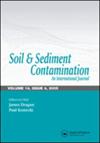Oxidation‐reduction chemistry of chromium: Relevance to the regulation and remediation of chromate‐contaminated soils
IF 1.5
4区 环境科学与生态学
Q4 ENVIRONMENTAL SCIENCES
引用次数: 93
Abstract
Developing health‐protective clean‐up standards and remediation strategies for chromium‐contaminated soils based on the hexavalent forms of this heavy metal is a complex and controversial issue, because certain forms of Cr(III) can oxidize to Cr(VI) and Cr(VI) can be reduced to Cr(III) under diverse soil conditions. The extent of oxidation of Cr(III) in soils amended with wastes is based on four interacting parameters: (1) solubility and form of Cr(III) related to oxidation (waste oxidation potential, or WOP), (2) reactive soil Mn(III,IV) (hydr)oxide levels (soil oxidation potential for Cr(III), or SOP), (3) soil potential for Cr(VI) reduction (soil reduction potential, or SRP), and (4) soil‐waste pH as a modifier of the first three parameters (pH modification value, or PMV). Each of these four parameters can be quantified with laboratory tests and ranked numerically; the sum of which is the Potential Chromium Oxidation Score (PCOS) for assessing the relative hazard of a waste‐soil combination. The PCOS v...铬的氧化还原化学:与铬酸盐污染土壤的调节和修复相关
基于六价形式的铬污染土壤的健康保护清理标准和修复策略是一个复杂而有争议的问题,因为某些形式的Cr(III)可以氧化为Cr(VI),而Cr(VI)可以在不同的土壤条件下还原为Cr(III)。用废物修饰的土壤中Cr(III)的氧化程度基于四个相互作用的参数:(1)与氧化相关的Cr(III)的溶解度和形态(废物氧化电位,或WOP),(2)活性土壤Mn(III,IV)(水合)氧化物水平(土壤Cr(III)的氧化电位,或SOP),(3)土壤Cr(VI)还原电位(土壤还原电位,或SRP),以及(4)土壤-废物pH值作为前三个参数的修饰剂(pH修饰值,或PMV)。这四个参数都可以通过实验室试验进行量化,并进行数值排序;其总和是用于评估废物-土壤组合的相对危害的潜在铬氧化评分(PCOS)。多囊卵巢综合征…
本文章由计算机程序翻译,如有差异,请以英文原文为准。
求助全文
约1分钟内获得全文
求助全文
来源期刊

Soil & Sediment Contamination
环境科学-环境科学
CiteScore
4.20
自引率
10.00%
发文量
53
审稿时长
2.2 months
期刊介绍:
When it comes to assessing and mitigating contaminated soils and sediments, there is no substitute for having the very latest tools, techniques and methodologies at your fingertips to help you deal with these issues efficiently and cost-effectively.
This is just the kind of essential expertise you’ll only find in Soil and Sediment Contamination . This internationally, peer-reviewed publication focuses on soil and sediment contamination from:
-Sludges-
Petroleum-
Petrochemicals-
Chlorinated hydrocarbons-
Pesticides-
Lead and other heavy metals.
Get detailed descriptions of all the latest and most efficient offsite and in situ remediation techniques, strategies for assessing health effects and hazards, and tips for dealing with everyday regulatory and legal issues. With the state-of-the-art tools that Soil and Sediment Contamination provides, you can successfully assess, mitigate, and solve both rural and urban soil contamination problems as efficiently and economically as possible.
 求助内容:
求助内容: 应助结果提醒方式:
应助结果提醒方式:


